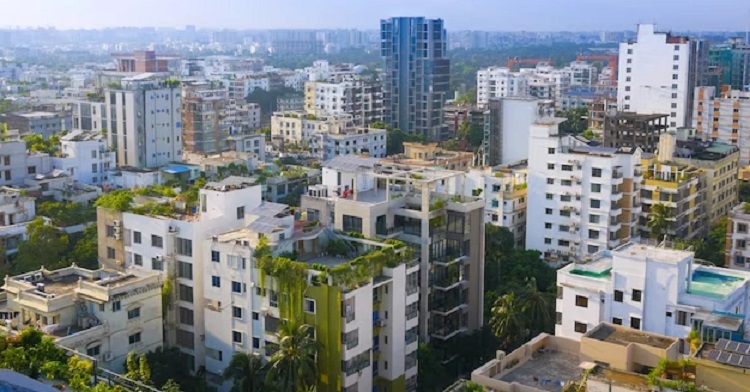Housing Sector Volatility: Soaring prices leave middle-class dreams dashed


Shahjalal Khan, a retired school headmaster from the bustling Mohammadpur neighbourhood, had long cherished the dream of securing a modest apartment in Dhaka—a peaceful corner to call his own after decades of service to the nation’s youth.
His wife, Rayea Akter, also on the cusp of retirement, shares the same aspiration.
But despite their combined savings of Tk75 lakh—accumulated over years of dedication—the dream now seems distant, even elusive.
“After the change in government, I no longer feel confident withdrawing our savings to purchase a flat,” Shahjalal told UNB.
“My pension, our combined earnings—it all adds up, yet it still falls short. And the registration fees add another 15 percent. It’s simply out of reach," he said.
Like many others in Bangladesh’s middle class, Shahjalal finds himself paralysed by economic uncertainty and political instability.
The couple, once hopeful, now hesitate to act—fearful of what the future might hold.
Stifled Growth in the Face of Crisis
The housing sector—once a cornerstone of urban development—is now faltering under the weight of multifaceted challenges.
The recent political transition, coupled with an interim government, a rise in construction costs, and unresolved issues surrounding the Detailed Area Plan (DAP), has plunged the real estate industry into a prolonged slump.
Besides, the silence from the authorities regarding the continuation of the provision allowing investment of undisclosed income in housing—by paying a 15 percent tax—has cast a shadow over the sector’s short-term future.
Buyers and investors, uncertain and wary, are choosing to wait.
Hope in Numbers, Not on the Ground
Yet amid the turbulence, global projections paint a more hopeful picture. According to market research firm Statista Market Insights, Bangladesh’s housing market is projected to reach US$2.75 trillion by the end of 2025. With an anticipated annual growth rate of 1.99 percent, the market is expected to expand to US$3.07 trillion by 2029.
The residential segment alone is forecasted to hit US$2.07 trillion in 2025, climbing to US$2.21 trillion by 2029 at a steady CAGR of 1.63 percent.
While China is poised to dominate the global real estate landscape with an astronomical US$115.4 trillion in 2025, Bangladesh’s sector is seen as steadily rising—driven by urbanisation and population growth.
Flat Sales in Free Fall
Md. Rasel Mukul, Assistant General Manager (Sales & Marketing) at Basic Builders Ltd, offered a sobering reality: flat sales have plummeted—down by 40 percent among middle-income buyers and by as much as 70 percent among the affluent.
“Flat bookings have dropped drastically. Even the sale of plots has dwindled,” he told UNB, reflecting the despair of countless small and medium-scale developers struggling to stay afloat.
Adding to the crisis is a steep hike in raw material costs. “There are 280 types of materials needed to construct a flat. Prices of some key items, like rods and cement, have soared by 25 percent due to inflation and land costs in DAP-affected areas,” explained Dawn Shahenul Kabir, Director (Construction), Eastern Housing.
This cascading cost inflation has effectively halted many new projects, while private home construction has stagnated.
The ripple effect is being felt across the supply chain, with plummeting demand for core materials.
For the past five months, the flat market has remained frozen, prompting some developers to sell units below cost just to stay solvent.
Many are struggling to cover operational expenses—paying staff salaries, managing office overheads—and praying for a turnaround if the economic tide turns.
One managing director from a midrange real estate company, requesting anonymity, shared that over 200 flats in their 30-plus projects across Dhaka remain unsold. Prices vary: in Banasree, flats go for Tk5,500–6,000 per square foot; in Bashundhara, Tk7,000–8,500; and in Jalsiri Housing, Tk9,000–9,500. These units range from 1,300 to 2,850 square feet.
“Sales in 2025 are already down by 20 percent compared to last year,” said Shahjahan Raihan, Chief Operating Officer of Sheltech (Pvt.) Limited. “Customers are simply not ready to invest amidst the prevailing political and economic uncertainty.”
REHAB Blames the DAP: A Sector Under Siege
The Real Estate and Housing Association of Bangladesh (REHAB) is sounding the alarm.
“After the change in government, many of the key investors—businessmen, bureaucrats, even politicians—have gone quiet,” said Liakat Ali Bhuiyan, REHAB’s senior vice president.
“The window to invest undeclared money has closed, cutting off a major flow of capital into the sector," he said.
At the heart of the controversy is the Detailed Area Plan (DAP), a blueprint designed by RAJUK to reshape Dhaka into a more liveable city. Enforced since August 2023, the plan has sparked intense debate. Developers argue that the new zoning laws are discriminatory and have crippled the industry.
“This DAP is nothing short of a death trap,” Liakat warned. “If not amended, the very industry that fuels employment across the nation is at risk of collapse," he said.
A Tug of War Over Dhaka’s Skyline
A RAJUK official, preferring anonymity, confirmed that a revised version of the DAP is nearing finalisation and will soon be gazetted following ministerial approval.
While REHAB welcomes the revision, urban planners express grave concern. They allege the government is capitulating to business interests at the expense of public welfare.
The most contentious changes involve a relaxation of the Floor Area Ratio (FAR), allowing buildings to rise higher than before:
Mirpur: from 5 to 7 storeys
Uttara Phase III: from 6 to 10 storeys
Mohammadpur: from 5 to 7 storeys
Bashundhara: from 6 to 8 storeys
Gulshan-Banani: from 11 to 12 storeys
Besides, water bodies will be categorised solely as such—prohibiting any filling—and agricultural land will be distinctly marked and protected without sub-classifications.
Urban Planners Cry Foul
Mohammad Fazle Reza Suman, former president of the Bangladesh Institute of Planners (BIP), did not mince words.
“No consultation was held with urban planners or city residents before increasing building heights,” he said. “The authorities are bending to the will of vested interests, sacrificing Dhaka’s livability.”
He warned that RAJUK’s apparent vision to turn Dhaka into a city of endless high-rises defies environmental logic and social equity.
“If the DAP and building codes must be amended, it should be through a transparent, consultative process. We’ve seen how height regulations were loosened in 2007 and 2008, then reined in again in 2022. Now, further loosening will only intensify population density and overburden the city’s fragile infrastructure,” he added.
A City Caught Between Growth and Gridlock
As the nation’s real estate sector hangs in limbo, torn between ambition and reality, the future of Dhaka’s urban landscape remains uncertain. Will the city rise, resilient and reimagined? Or will it collapse under the weight of its contradictions—soaring towers above, and faltering trust below?
